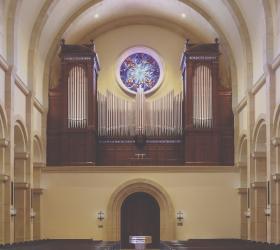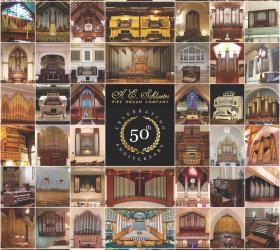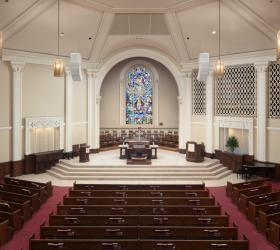
St. Cecilia’s Abbey
Ryde, Isle of Wight, England
Kenneth Tickell & Co. Ltd., Northampton
The diamond-shaped Isle of Wight, 22.5 miles long and 13.5
wide, four miles off the south coast of Hampshire, England, is separated from
the mainland by the Solent Sea. Vectis, as the Romans knew it, is a stunning
island with its lush green and copses, trim hedgerows, grand chalk cliffs and
rolling downs, fishing villages, thatched roof cottages nestled amid the
heather and the gorse, idyllic panoramic beaches that stretch for miles. The
Caulkheads (born on the Island), Grockles (visitors) and Overners (new
residents) provide a hearty welcome to their magnificent landscape with its
Carisbrooke Castle; Osborne House, the Italian Villa which was Queen
Victoria’s favorite home, and the Baroque elegance of Appuldurcombe, the
Worsley family estate for over 300 years.
While making several retreats at the Solesmes Benedictine
Abbey of Quarr at Binstead, I visited St. Cecilia’s Abbey, which
overlooks the sea at Ryde. Founded in 1882, it became a part of the Solesmes
Congregation in 1950, an international (Benedictine) congregation of monks and
nuns, with 28 monasteries dispersed over three continents. I well remember
hearing the old pipe organ which was a real ‘bag of whistles’, loud
and louder! The sisters--under the leadership of Mother Abbess Ninian
Eaglesham, O.S.B., and the retired Abbess Bernadette Smeyers, O.S.B., who
celebrated her 100th birthday on the 5th of August, 2003--are to be
commended for their determination to replace the old ‘battleship’
with a new pipe organ.
After numerous planning and listening sessions, which
involved discussions with the sisters’ committee and their consultant
Joseph Cullen, the organbuilding firm of Kenneth Tickell & Company Ltd.,
Northampton, was selected to remove the old organ, extend the gallery front,
and build a new organ whose primary focus is to accompany the chant.
Cullen’s comments on the liturgical musician’s approach to this
monastic organ follow:
“The prime duty for the Ryde organ is to accompany
Gregorian chant, sung by one, a few, or all the voices of the monastic
community. Additionally, the congregation would occasionally require support.
Contrary to the normal approach of building up organ tone by combining pitches
above the unison, there is a primary need for the chant to be underpinned by
8’ pitches.
“My own rationale behind this is as follows: Plainsong
was developed as a self-sufficient mode of singing; organ accompaniment might
be reasonably viewed as just a way of supporting the voices, keeping the vocal
line, and the pitch. The last thing which the organ sound should do is to sing
above the voices. All this may seem painfully subservient, but therein lies the
beauty of the art of monastic accompaniment. There still remains complete
freedom for subtlety and invention, but this form of accompaniment is the
servant of the chant which, in its turn, is the servant of the daily round of
prayer of the monastic community.
“Simple so far, yet quite demanding in that these core
foundation ranks must be voiced perfectly in order to blend with each other,
the building and the nuns’ singing. And now I would like to give some
explanation for the luxurious full length bass of the Salicional and
independent basses for the two 8’ flutes. Psalm tones often require a held
chord of quite lengthy duration when the bottom note is often in the bass
octave. Such is the acuteness of their ears and sensibility to accompaniment
that the nuns asked that there be no breaking into stopped basses for the open
8’ ranks. Since these registers are more often than not used singly, this
became an unusual but quite justifiable priority.
“There was a wish that this organ provide the timbres
for, and rewards of playing, a range of organ repertoire. With the monastery
links to St. Pierre de Solesmes Abbey in France came a penchant for French
repertoire, and the Oboe was thought to be a worthwhile dream stop. This stop
can be used as a gentle Basse de Trompette (with the 4’ and 2’),
Pedal Bassoon by coupler, a Cromorne with the 4’ flute, a Jeux de Fonds
with the two 8’ flues, a solo voice for chorale preludes and as a chorus
reed with 8’, 4’ and 2’ principals. Even a virtual Grands Jeux
can be simulated in combination with the mutations.
“The use of mutations as treble range solo registers
is more apparent, but in this case, as there was the space, it was thought that
full-range stops would be useful especially in contrapuntal writing where gaps
might be noticed. What a pleasure it is to explore the myriad permutations
which the player can discover with these stops, and I should also point out
that these two ranks can be combined with the 8’ Open in some delectable
ways.
“Lastly, if you imagine that a great decision had to
be made about including a Mixture, then be reassured. If you could experience
the peace and tranquility of this place on the Isle of Wight, then it might
become clear what little use it might have had!”
And from Mr. Kenneth Tickell, the organbuilder, we have a
descriptive analysis of the design and construction of the organ, as well as
the reconstruction of the organ gallery.
“The casework is based on a full length Open Diapason,
necessary to adequately fill the arch in the organ gallery. As well as the
organ, the community commissioned us to extend the gallery, to build a new
gallery front and new paneling below the gallery, and supply new screens for
the stonework openings to either side of the organ arch. The gallery front
incorporates pierced gothic tracery panels which are stylistically linked with the
organ pipeshades, as are the side screens. All of the new woodwork, including
the organ case, is finished in its natural color, the whole reading as a single
composition at the end of the church with the intention of creating a lighter,
more delicate effect, in contrast to the heavy, dark treatment of the previous
gallery structure.
“The organ has two manuals and twelve stops. As in a
monastic organ we made for Pluscarden Abbey, near Elgin in Scotland, all ranks
are enclosed, with the exception of the Open Diapason and Bourdon, enabling the
majority of the organ to be balanced with voices.
“Construction began in our workshop in early 2003,
together with the new oak gallery front and paneling; however, a small central
extension of the balustrade was made which would allow the new instrument to
sit sufficiently far forward to accommodate a steel tie-rod fitted across the
arch which could then pass behind the front pipes of the new organ and in front
of the swell shutters.”
The organist for the dedication and blessing on 23 November
2003 was Joseph Cullen, a native of Glasgow, organ scholar of Trinity College,
Cambridge, and subsequently organist and choirmaster at St. Andrew’s
Cathedral, Glasgow, director of music at Leeds Cathedral, assistant director of
the Groupe Vocal de France, assistant master of music at Westminster Cathedral
and currently chorus master of the Huddersfield Choral Society and the London
Symphony Chorus. Celebrant for this grand occasion was the Rev. Fr. Prior
Cuthbert Brogan, O.S.B. of St. Michael’s Abbey, Farnborough, Hampshire.
--Peter J. Basch, KCHS
MANUAL I (C-g, 56 notes)
8' Open
Diapason
8' Clarabella
4' Principal
22⁄3' Nazard
2' Fifteenth
13⁄5' Tierce
MANUAL II (C-g, 56 notes)
8' Stopped
Diapason
8' Salicional
4' Chimney
Flute
2' Flageolet
8' Oboe
PEDAL (C-f, 30 notes)
16' Subbass
Couplers
II
to I
I
to Pedal
II
to Pedal
Tremulant to the whole organ
Mechanical key action
Keyboards C-g, 56 notes, bone coverings with blackwood sharps
Pedalboard C-f, 30 notes, oak, radiating and concave
All 8' ranks are full compass.




